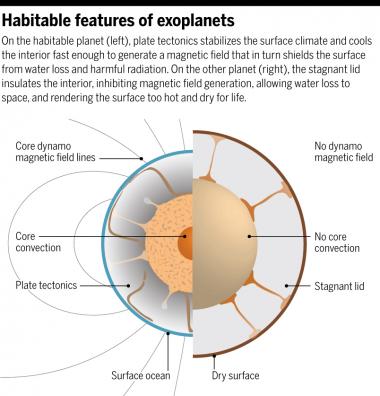'De inwendige dynamiek is wat telt voor de bewoonbaarheid van planeten'
allesoversterrenkunde.nl, 2 mei 2019
Bron: Carnegie Institution for Science
Een team van onderzoekers op het gebied van de geochemie, planeetwetenschappen en astronomie wijzen deze week in Science op het grote belang van de inwendige dynamiek van planeten bij het creëeren van een leefbare omgeving. De leefbaarheid van een planeet is volgens hen maar zeer ten dele afhankelijk van makkelijk waarneembare factoren zoals de temperatuur of de samenstelling van de atmosfeer.
Als voorbeeld noemen ze de platentektoniek, die op aarde een cruciale rol speelt bij het in stand houden van een oppervlakteklimaat dat gunstig is voor leven. Bovendien zou de convectie die het aardmagnetische veld aandrijft niet mogelijk zijn zonder de circulatie van materiaal tussen het oppervlak en het inwendige van onze planeet. En zonder magnetisch veld zou het aardoppervlak voortdurend worden bestookt met kosmische straling.

inwendige eigenschappen noodzakelijk
voor bewoonbaarheid van een planeet
Volgens de wetenschappers is er behoefte aan een beter begrip van hoe de samenstelling en het inwendige van een planeet diens leefbaarheid beïnvloedt. Dat begint al bij het planeetvormingsproces: in principe zullen alle rotsachtige planeten kunnen beschikken over elementen als silicium, magnesium, zuurstof, koolstof, ijzer en waterstof. Bepalend voor hun inwendige chemie en indirect ook voor de samenstelling van hun atmosfeer en de omvang van hun oceanen, is echter
- in welke verhoudingen deze elementen aanwezig zijn en
- welke opwarming en afkoeling de jonge planeten ondergaan.
De auteurs van het essay in Science stellen dan ook dat de zoektocht naar buitenaards leven om een interdisciplinaire aanpak vraagt, waarbij astronomische waarnemingen worden gecombineerd met laboratoriumexperimenten en computermodellen en -simulaties.
In het volgende decennium komt een nieuwe generatie van telescopen in bedrijf waarmee serieus kan worden gezocht naar biosignaturen in de atmosferen van rotsachtige planeten. Om iets zinnigs te zeggen over de leefbaarheid van zo'n planeet zou de eventuele ontdekking van zo'n biosignatuur echter altijd in een bredere context moeten worden geplaatst. (EE)
Bron:
Carnegie Science - When It Comes to Planetary Habitability, It's What's Inside That Counts
Washington, DC - Which of Earth's features were essential for the origin and sustenance of life? And how do scientists identify those features on other worlds?
A team of Carnegie investigators with array of expertise ranging from geochemistry to planetary science to astronomy published this week in Science an essay urging the research community to recognize the vital importance of a planet's interior dynamics in creating an environment that's hospitable for life.
With our existing capabilities, observing an exoplanet's atmospheric composition will be the first way to search for signatures of life elsewhere. However, Carnegie's Anat Shahar, Peter Driscoll, Alycia Weinberger and George Cody argue that a true picture of planetary habitability must consider how a planet's atmosphere is linked to and shaped by what's happening in its interior.

inwendige eigenschappen noodzakelijk
voor bewoonbaarheid van een planeet
For example, on Earth, plate tectonics are crucial for maintaining a surface climate where life can thrive. What's more, without the cycling of material between its surface and interior, the convection that drives the Earth's magnetic field would not be possible and without a magnetic field, we would be bombarded by cosmic radiation.
"We need a better understanding of how a planet's composition and interior influence its habitability, starting with Earth," Shahar said. "This can be used to guide the search for exoplanets and star systems where life could thrive, signatures of which could be detected by telescopes."
It all starts with the formation process. Planets are born from the rotating ring of dust and gas that surrounds a young star. The elemental building blocks from which rocky planets form - silicon, magnesium, oxygen, carbon, iron, and hydrogen - are universal. But their abundances and the heating and cooling they experience in their youth will affect their interior chemistry and, in turn, things like ocean volume and atmospheric composition.
"One of the big questions we need to ask is whether the geologic and dynamic features that make our home planet habitable can be produced on planets with different compositions," Driscoll explained. The Carnegie colleagues assert that the search for extraterrestrial life must be guided by an interdisciplinary approach that combines astronomical observations, laboratory experiments of planetary interior conditions, and mathematical modeling and simulations.
"Carnegie scientists are long-established world leaders in the fields of geochemistry, geophysics, planetary science, astrobiology and astronomy," said Weinberger. "So, our institution is perfectly placed to tackle this cross-disciplinary challenge."
In the next decade as a new generation of telescopes come online, scientists will begin to search in earnest for biosignatures in the atmospheres of rocky exoplanets. But the colleagues say that these observations must be put in the context of a larger understanding of how a planet's total makeup and interior geochemistry determines the evolution of a stable and temperate surface where life could perhaps arise and thrive.
"The heart of habitability is in planetary interiors," concluded Cody.
terug naar het antropisch principe
terug naar het weblog
^